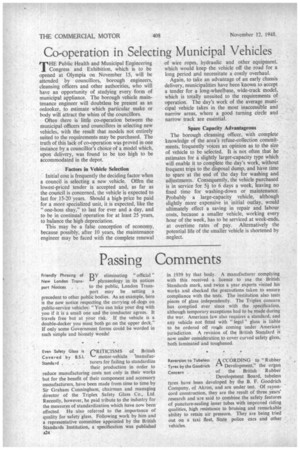Co-operation in Selecting Municipal Vehicles
Page 26

If you've noticed an error in this article please click here to report it so we can fix it.
THE Public Health and Municipal Engineering Congress and Exhibition, which is to be opened at Olympia on November 15, will be attended by councillors, borough engineers, cleansing officers and other authorities, who will have an opportunity of studying every form of municipal appliance. The borough vehicle maintenance engineer will doubtless be present as an onlooker, to estimate which particular make or body will attract the whim of the councillors.
Often there is little co-operation between the municipal officers and councillors in selecting new vehicles, with the result that models not entirely suited to the requirements may be purchased. The truth of this lack of co-operation was proved in one instance by a councillor's choice of a model which, upon delivery, was found to be too high to be accommodated in the depot.
Factors in Vehicle Selection Initial cost is frequently the deciding factor when a council is selecting a new vehicle. Often the lowest-priced tender is accepted and, as far as the council is concerned, the vehicle is expected to last for 15-20 years. Should a high price be paid for a more specialized unit, it is expected, like the " one-hoss shay," to last for ever and a day, and to be in continual operation for at least 25 years, to balance the high depreciation.
This may be a false conception of economy, because possibly, after 10 years, the maintenance engineer may be faced with the complete renewal of wire ropes, hydraulic and other equipment, which would keep the vehicle off the road for a long period and necessitate a costly overhaul.
Again, to take an advantage of an early chassis delivery, municipalities have been known to accept a tender for a long-wheelbase, wide-track model, which is totally unsuited to the requirements of operation. The day's work of the average municipal vehicle takes in the most inaccessible and narrow areas, where a good turning circle and narrow track are essential.
Spare Capacity Advantageous The borough cleansing officer, with complete knowledge of the area's refuse-collection commitments, frequently voices an opinion as to the size of vehicle to be selected. It is not often that he estimates for a slightly larger-capacity type which will enable it to complete the day's work, without frequent trips to the disposal dump, and have time to spare at the end of the day for washing and adjustments. Consequently, the vehicle purchased is in service for 5i to 6 days a week, leaving no fixed time for washing-down or maintenance. Probably a large-capacity vehicle, although slightly more expensive in initial outlay, would ultimately effect a saving in repair and labour costs, because a smaller vehicle, working every hour of the week, has to be serviced at week-ends, at overtime rates of pay. Alternatively the potential life of the smaller vehicle is shortened by neglect.




























































































